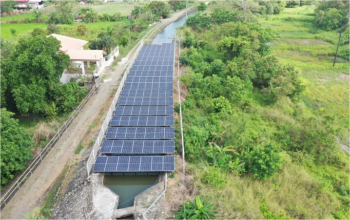
The Philippine government's National Irrigation Authority has revealed that solar arrays on two canals used for irrigation have recently been put into use. The bureau also said that 147 solar irrigation projects will be completed in the country by the end of this year, and 183 projects are planned to be completed in 2024.
The Philippine government's irrigation development and management company, the National Irrigation Authority (NIA), announced last week that the country plans to develop 183 solar irrigation projects next year, up 24.4 percent from the 147 projects completed this year.
This year's project totals 830 hectares of irrigated agricultural land at a total cost of PHP1,643,583,002 (US $29 million). As of September 15, 17 solar irrigation projects have been completed. The agency estimates that next year's project is expected to cost PHP1,720,984,000 and can irrigate 2,168 hectares of agricultural land.
In the completed project, two photovoltaic arrays were deployed on top of the irrigation canal. Aqueduct solar projects are proliferating around the world. Countries such as Spain, India, France, the United States and Pakistan have all announced recent projects, but only a handful have materialized so far. These projects provide electricity without taking up land and reducing water evaporation.
The two projects, located in the central part of Luzon, are the 350-hectare Buspan solar pump irrigation system in Marameg and the Anbuspa solar pump irrigation system in Tibagan. The latter replicates Bulacan's NIA Region Phase III project, which installed 155 solar panels with a capacity of 60 KW on top of an irrigation canal.
The agency says it is promoting solar irrigation projects, working to replace "expensive diesel pumps" with solar pumps, and firmly believes that solar is the "most accessible and economically viable" of all renewable energy sources.
"As gasoline and diesel prices soar, these projects can continue to be used to irrigate land without incurging high fuel costs," the agency said in a statement, "the technology consists of solar panels, pumps, electronic pump controllers, storage tanks and transmission systems." Solar pumps are considered more cost effective than fuel irrigation pumps due to their low operating costs."
According to a report published by the International Renewable Energy Agency (IRENA) in 2022, the Philippines aims to achieve 15 GW of clean energy installations by 2030, and due to the country's archipelagic nature, the country is likely to focus more on microgrids and standalone clean power systems.